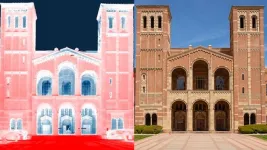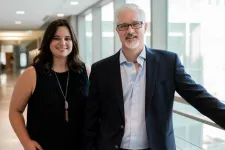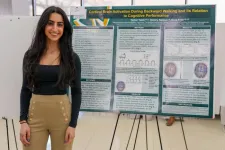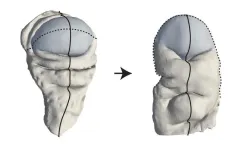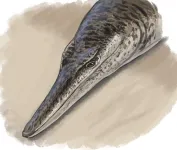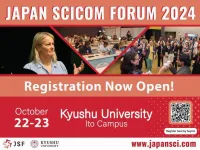(Press-News.org) With temperatures rising globally, the need for more sustainable cooling options is also growing. Researchers at UCLA and their colleagues have now found an affordable and scalable process to cool buildings in the summer and heat them in the winter.
Led by Aaswath Raman, an associate professor of materials science and engineering at the UCLA Samueli School of Engineering, the research team recently published a study in Cell Reports Physical Science detailing a new method to manipulate the movement of radiant heat through common building materials to optimize thermal management.
Radiant heat, which is felt whenever a hot surface warms our bodies and homes and is carried by electromagnetic waves, travels across the entire broadband spectrum at ground level between buildings and their environments, such as streets and neighboring structures. On the other hand, heat moves between buildings and the sky in a much narrower portion of the infrared spectrum known as the atmospheric transmission window. The difference in how radiant heat travels between buildings and the sky versus the ground has long presented a challenge to cooling buildings with less skyward-facing surfaces. These buildings have been hard to cool in the summer as they retain heat from the ground and neighboring walls when the outside temperature is high. They are equally difficult to warm in wintertime as the outdoor temperature drops and the buildings lose heat.
“If we look at historical cities like Santorini in Greece or Jodhpur in India, we find that cooling buildings by making roofs and walls reflect sunlight has been practiced for centuries,” said Raman, who leads the Raman Lab at UCLA Samueli. “In recent years there has been massive interest in cool roof coatings that reflect sunlight. But cooling walls and windows is a much more subtle and complex challenge.”
However, with the proven success of cooling buildings by using super white paint on the roofs to reflect sunlight and radiate heat into the sky, the researchers set out to create a similar passive radiative cooling effect by coating walls and windows with materials that can better manage heat movement between buildings and their surroundings at ground level. The researchers demonstrated that materials capable of preferentially absorbing and emitting radiant heat within the atmospheric window could stay cooler than conventional building materials in the summer and warmer than they could during the winter.
“We were particularly excited when we found that materials like polypropylene, which we sourced from household plastics, can selectively radiate or absorb heat in the atmospheric window very effectively,” Raman said. “These materials border on the mundane, but the same scalability that makes them common also means that we could see them thermoregulating buildings in the near future.”
In addition to leveraging easily accessible cost-saving materials, the team’s approach also has the added benefit of saving energy by reducing the reliance on air conditioners and heaters that are not only costly to run but also contribute to carbon dioxide emissions.
“The mechanism we proposed is completely passive, which makes it a sustainable way to cool and heat buildings with the seasons and yield untapped energy savings,” said Jyotirmoy Mandal, the study’s first author and a former postdoctoral scholar in Raman’s lab. Mandal is now a civil and environmental engineering assistant professor at Princeton University.
According to the researchers, the new methodology can scale easily and will be especially impactful on low-income communities with limited or no access to cooling and heating systems that have seen increasing casualties resulting from extreme weather events across the globe.
Raman and his team are exploring ways to demonstrate this effect at larger building scales and its real-world energy savings, particularly in heat-vulnerable communities in Southern California.
The study was funded in part by a Schmidt Science fellowship, the Rhodes Trust, the Alfred P. Sloan Foundation and the National Science Foundation. Other authors of the paper are John Brewer — a recent Ph.D. graduate from Raman’s lab, Jyothis Anand of Oak Ridge National Lab, Arvind Ramachandran of Arizona State University and independent researcher Sagar Mandal.
END
Researchers discover new mechanism to cool buildings while saving energy
A low-cost approach regulates heat with common building materials that absorb or radiate heat
2024-08-09
ELSE PRESS RELEASES FROM THIS DATE:
New study will provide HIV prevention and treatment for incarcerated people with opioid use disorder
2024-08-09
The University of Massachusetts Amherst and Tufts Medical Center are conducting a study to provide HIV prevention, diagnosis and treatment for people with opioid use disorders who are incarcerated in the Boston area.
The study is funded with a $4.74 million CONNECT grant from the National Institute on Drug Abuse (NIDA), part of the National Institutes of Health (NIH).
Elizabeth Evans, professor of community health education in the UMass Amherst School of Public Health and Health Sciences, and Dr. Alysse Wurcel, a ...
Russian invasion of Ukraine could have lasting impacts on global economy, environment
2024-08-09
As the Russian invasion of Ukraine stretches into its third year, international trade has felt the effects as sanctions on Russian exports have expanded. Now researchers have found that the invasion may not only have significant short-term impacts on the global timber markets but may leave lasting effects on the global economy and the environment.
These findings are detailed in a new study which projects the impact of sanctions on Russia and military disruption in Ukraine on the global wood product markets. Researchers compared two projected scenario outcomes based on the Global Forest Products Market model, one ...
Investigating a critical factor for promoting drug-context associations and relapse
2024-08-09
Most people wouldn’t think twice after seeing sugar spilled on a counter. But for someone with a history of cocaine use, this visual cue could trigger powerful associations with their past drug use and a compulsive urge to seek the drug.
Certain circuits within the brain help to form natural associations between one’s experiences and the context in which those experiences occur. These associations play a critical role in the orchestration of adaptive learning. When addictive substances are introduced, this coupling mechanism can be hijacked so that ...
New material for optically-controlled magnetic memory discovered
2024-08-09
Researchers at the University of Chicago Pritzker School of Molecular Engineering (PME) have made unexpected progress toward developing a new optical memory that can quickly and energy-efficiently store and access computational data. While studying a complex material composed of manganese, bismuth and tellurium (MnBi2Te4), the researchers realized that the material’s magnetic properties changed quickly and easily in response to light. This means that a laser could be used to encode information ...
Detroit research team to investigate fear of falling in MS patients
2024-08-09
DETROIT — Taylor Takla, a Ph.D. candidate in the translational neuroscience program in Wayne State University’s School of Medicine, recently received a two-year, $96,812 F31 grant from the Eunice Kennedy Shriver National Institute of Child Health and Human Development of the National Institutes of Health to study fear of falling in those with multiple sclerosis (MS).
The grant, “Investigating Fear of Falling in Multiple Sclerosis: An Interplay of Neural, Motor, Cognitive, and Psychological Factors,” aims to address a major public health concern in persons with MS that results in increased falls, decreased physical activity and ...
A new mechanism for shaping animal tissues
2024-08-09
A key question that remains in biology and biophysics is how three-dimensional tissue shapes emerge during animal development. Research teams from the Max Planck Institute of Molecular Cell Biology and Genetics (MPI-CBG) in Dresden, Germany, the Excellence Cluster Physics of Life (PoL) at the TU Dresden, and the Center for Systems Biology Dresden (CSBD) have now found a mechanism by which tissues can be “programmed” to transition from a flat state to a three-dimensional shape. To accomplish this, the researchers looked at the development of the fruit fly Drosophila and its ...
New ancient marine crocodile from time of dinosaurs provides insight into the groups lifestyle and diversity
2024-08-09
New ancient marine crocodile from time of dinosaurs provides insight into the groups lifestyle and diversity
A newly discovered species of marine crocodile from 135 million years ago described from Germany
An international team of scientists, including researchers from Germany and the UK, have described a new species of ancient marine crocodile, Enalioetes schroederi. Enalioetes lived in the shallow seas that covered much of Germany during the Cretaceous Period, approximately 135 million years ago.
This ...
CMU researchers outline promises, challenges of understanding AI for biological discovery
2024-08-09
Machine learning is a powerful tool in computational biology, enabling the analysis of a wide range of biomedical data such as genomic sequences and biological imaging. But when researchers use machine learning in computational biology, understanding model behavior remains crucial for uncovering the underlying biological mechanisms in health and disease.
In a recent article in Nature Methods, researchers at Carnegie Mellon University's School of Computer Science propose guidelines that outline pitfalls and opportunities for using interpretable ...
Japan SciCom Forum 2024 comes to Fukuoka on October 22-23
2024-08-09
On October 22 and 23, the sixth Japan SciCom Forum Conference (JSF 2024) will be held at Kyushu University's Ito Campus. Fukuoka will become the third city, following Tokyo and Okinawa, to welcome specialists in science communication from Japan and around the world.
JSF 2024 will bring together a diverse group of science communicators, writers, researchers, and journalists, along with experts from overseas. The conference is open to anyone involved in sharing research findings internationally, as well as those interested in science communication, public outreach, and engagement.
This year's JSF will explore a wide range of topics, including ...
Organic farms certified by peers display higher product diversity
2024-08-09
In Brazil, a study compared two systems of organic product certification implemented in São Paulo state. One system involves conventional certification by auditors accredited by the Ministry of Agriculture and the National Institute of Metrology, Quality and Technology (INMETRO). The other is peer-to-peer certification.
The study, reported in an article published in the journal Organic Agriculture, suggests that peer-to-peer certification adds the virtue of agrobiodiversity to organic farming in light of the significantly larger number of products offered by farms with this type of certification. “This ...
LAST 30 PRESS RELEASES:
Air pollution exposure and birth weight
Obstructive sleep apnea risk and mental health conditions among older adults
How talking slows eye movements behind the wheel
The Ceramic Society of Japan’s Oxoate Ceramics Research Association launches new international book project
Heart-brain connection: international study reveals the role of the vagus nerve in keeping the heart young
Researchers identify Rb1 as a predictive biomarker for a new therapeutic strategy in some breast cancers
Survey reveals ethical gaps slowing AI adoption in pediatric surgery
Stimulant ADHD medications work differently than thought
AI overestimates how smart people are, according to HSE economists
HSE researchers create genome-wide map of quadruplexes
Scientists boost cell "powerhouses" to burn more calories
Automatic label checking: The missing step in making reliable medical AI
Low daily alcohol intake linked to 50% heightened mouth cancer risk in India
American Meteorological Society announces Rick Spinrad as 2026 President-Elect
Biomass-based carbon capture spotlighted in newly released global climate webinar recording
Illuminating invisible nano pollutants: advanced bioimaging tracks the full journey of emerging nanoscale contaminants in living systems
How does age affect recovery from spinal cord injury?
Novel AI tool offers prognosis for patients with head and neck cancer
Fathers’ microplastic exposure tied to their children’s metabolic problems
Research validates laboratory model for studying high-grade serous ovarian cancer
SIR 2026 delivers transformative breakthroughs in minimally invasive medicine to improve patient care
Stem Cell Reports most downloaded papers of 2025 highlight the breadth and impact of stem cell research
Oxford-led study estimates NHS spends around 3% of its primary and secondary care budget on the health impacts of heat and cold in England
A researcher’s long quest leads to a smart composite breakthrough
Urban wild bees act as “microbial sensors” of city health.
New study finds where you live affects recovery after a hip fracture
Forecasting the impact of fully automated vehicle adoption on US road traffic injuries
Alcohol-related hospitalizations from 2016 to 2022
Semaglutide and hospitalizations in patients with obesity and established cardiovascular disease
Researchers ‘listen in’ to embryo-mother interactions during implantation using a culture system replicating the womb lining
[Press-News.org] Researchers discover new mechanism to cool buildings while saving energyA low-cost approach regulates heat with common building materials that absorb or radiate heat
